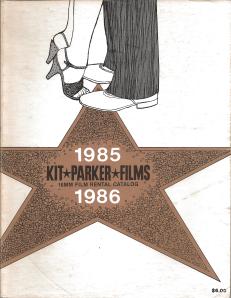Posts Tagged ‘Bill Grant’
Kit Parker Films @40 (Part 3)
Posted by: Kit Parker Films on: November 26, 2011
We had a problem – lack of exclusives
Just about everything in my library was also distributed by others, so we kept our overhead and prices low to compete with them. Our 1980-81 catalog was over 350 pages.
Then along came NTA (National Telefilm Associates) who during the 1950s-60s was one of he major syndicators of feature films and television programs. They owned the Republic Pictures and NBC libraries, and lots of really good independent productions such as those produced by Stanley Kramer. But NTA didn’t keep up with the times and became just a shadow of its former glory. In the late 1970s they agreed to license me some of their best feature films: High Noon, The Quiet Man, Johnny Guitar, It’s a Wonderful Life, and others but, again, non-exclusively.
By the early 1980s VHS began to rapidly put 16mm libraries out of business because it was far cheaper than 16mm film. KPF grew because of our high print quality standards; and fortunately, there were still customers who were interested in the big screen experience, which VHS could never match.
By the mid-1980s the NTA contract expired, some savvy executives had taken over the company, re-named it Republic Pictures, and turned it into a major home video label. One of the execs was Phil Kromnick, and I made a deal with him for the exclusive theatrical and non-theatrical rights to the entire Republic library. Fortunately Kromnick, and Republic’s president, Steve Beeks, believed in me, and it allowed Kit Parker Films to move on to its second phase…theatrical distribution.
Republic had a lot of junk, but they also had some real gems which I never distributed before such as “La Dolce Vita,” “Invasion of the Body Snatchers” (1956), “Operation Petticoat,” “Letter From an Unknown Woman,” and Max Fleischer cartoons, including Betty Boop. By this time television used video tape exclusively, so Republic gave me all of their 35mm and 16mm prints. I saved a lot of money because new prints were very expensive to manufacture, and obtaining good condition used copies saved me a lot of money, and freed up capital for further acquisitions and expansion.
The 1980s was the slippery slope for film libraries, particularly for the ones who serviced traditional government and institutional accounts like public libraries, camps, and YMCA’s; they all witched to video tape. By the mid to late 1980s I had purchased what was left of the once-stalwart Twyman Films, Clem Williams Films, and Wholesome Film Center, with the goal of obtaining whatever classic they might still have. The libraries had deals with Warner Bros., whom we never dealt with, so I went to Bill Grant, who was in charge of non-theatrical for that studio and asked him if he would let me retain the prints of Warner titles acquired from the libraries I had purchased. Bill said no because he didn’t want me in competition with WB’s flagship non-theatrical distributor, Swank Motion Pictures, but did ask if I would be interested in distributing some of their classics theatrically.
At that time Warner only owned the movies it made after 1948, so there was no “Casablanca,” but some good ones nevertheless, like “Rebel Without a Cause,” “A Streetcar Named Desire,” and those great Warner Bros. cartoons. Bill gave me 30 titles to start with and see what I could do, and within six months we had doubled the number of bookings. WB was making more money and extending absolutely no work to do so. The exhibitors were thrilled because they now were guaranteed excellent service and prints. Bill was happy, and I was glad to have him and his boss, Warner Bros. head of distribution, Barry Reardon, champion my work. Reardon, incidentally, was the Dean of Motion Picture Distribution.
But money was really not what motivated Warner Bros., as classics and their backlog library in general was but a fly speck for a company that was releasing blockbusters. In those days studios had a couple of dozen branches all around the country servicing their customers. When a particular branch was asked to book a classic, or cartoon, the same people who were scheduling the big hits had to stop what they were doing and find a branch that had a print (it could have been in over 30 different warehouses around the country), pray it was in good condition, and get it shipped to the proper branch for further shipping to the exhibitor. Each booking cost WB $125 in overhead, and sometimes that amount again in shipping charges…all for a $250 rental. I was a hero with the Warner Bros. distribution team because their former burden was reduced to telling their customers three words, “Call Kit Parker.”
Truckloads of WB prints started arriving, and we built up a theatrical business that was more substantial and profitable than our 16mm business ever war. The people at Warner Bros. really made me feel like part of their family.
P.S. I also built a 35mm theatre in my home…a thrill of thrills for a movie buff.
To be continued.
——————
Visit our website to order DVDs from the Kit Parker Films Collection –
Keep up to date with our new Sprocket Vault releases by liking us on Facebook www.facebook.com/sprocketvault/
Also, be sure to subscribe to our YouTube channel:
https://www.youtube.com/channel/UCLHjjG-o5Ny5BDykgVBzdrQ


